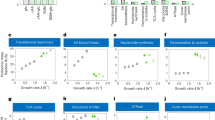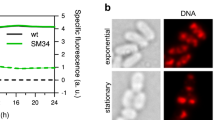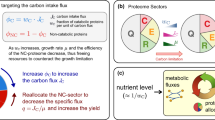Abstract
For cells to grow faster they must increase their protein production rate. Microorganisms have traditionally been thought to accomplish this increase by producing more ribosomes to enhance protein synthesis capacity, leading to the linear relationship between ribosome level and growth rate observed under most growth conditions previously examined. Past studies have suggested that this linear relationship represents an optimal resource allocation strategy for each growth rate, independent of any specific nutrient state. Here we investigate protein production strategies in continuous cultures limited for carbon, nitrogen and phosphorus, which differentially impact substrate supply for protein versus nucleic acid metabolism. Unexpectedly, we find that at slow growth rates, Escherichia coli achieves the same protein production rate using three different strategies under the three different nutrient limitations. Under phosphorus (P) limitation, translation is slow due to a particularly low abundance of ribosomes, which are RNA-rich and thus particularly costly for phosphorous-limited cells. Under nitrogen (N) limitation, translation elongation is slowed by processes including ribosome stalling at glutamine codons. Under carbon (C) limitation, translation is slowed by accumulation of inactive ribosomes not bound to messenger RNA. These extra ribosomes enable rapid growth acceleration during nutrient upshift. Thus, bacteria tune ribosome usage across different limiting nutrients to enable balanced nutrient-limited growth while also preparing for future nutrient upshifts.
This is a preview of subscription content, access via your institution
Access options
Access Nature and 54 other Nature Portfolio journals
Get Nature+, our best-value online-access subscription
$29.99 / 30 days
cancel any time
Subscribe to this journal
Receive 12 digital issues and online access to articles
$119.00 per year
only $9.92 per issue
Buy this article
- Purchase on Springer Link
- Instant access to full article PDF
Prices may be subject to local taxes which are calculated during checkout




Similar content being viewed by others
References
You, C. et al. Coordination of bacterial proteome with metabolism by cyclic AMP signalling. Nature 500, 301–306 (2013).
Li, G.-W., Burkhardt, D., Gross, C. & Weissman, J. S. Quantifying absolute protein synthesis rates reveals principles underlying allocation of cellular resources. Cell 157, 624–635 (2014).
Scott, M., Klumpp, S., Mateescu, E. M. & Hwa, T. Emergence of robust growth laws from optimal regulation of ribosome synthesis. Mol. Syst. Biol. 10, 747–747 (2014).
Giordano, N., Mairet, F., Gouzé, J.-L., Geiselmann, J. & de Jong, H. Dynamical allocation of cellular resources as an optimal control problem: novel insights into microbial growth strategies. PLoS Comput. Biol. 12, e1004802 (2016).
Dennis, P. P. & Bremer, H. Modulation of chemical composition and other parameters of the cell at different exponential growth rates. EcoSal Plus https://doi.org/10.1128/ecosal.5.2.3 (2008).
Neidhardt, F. C. & Magasanik, B. Studies on the role of ribonucleic acid in the growth of bacteria. Biochim. Biophys. Acta 42, 99–116 (1960).
Baracchini, E. & Bremer, H. Determination of synthesis rate and lifetime of bacterial mRNAs. Anal. Biochem. 167, 245–260 (1987).
Schaechter, M., Maaløe, O. & Kjeldgaard, N. O. Dependency on medium and temperature of cell size and chemical composition during balanced growth of Salmonella typhimurium. Microbiology 19, 592–606 (1958).
Scott, M., Gunderson, C. W., Mateescu, E. M., Zhang, Z. & Hwa, T. Interdependence of cell growth and gene expression: origins and consequences. Science 330, 1099–1102 (2010).
Yamamoto, T., Izumi, S. & Gekko, K. Mass spectrometry of hydrogen/deuterium exchange in 70S ribosomal proteins from E. coli. FEBS Lett. 580, 3638–3642 (2006).
Nomura, M. & Gourse, R. Regulation of the synthesis of ribosomes and ribosomal components. Annu. Rev. Biochem. 53, 75–117 (1984).
Maaloe, O. & Kjeldgaard, N. O. Control of Macromolecular Synthesis (WA Benjamin, New York, 1966).
Dai, X. et al. Reduction of translating ribosomes enables Escherichia coli to maintain elongation rates during slow growth. Nat. Microbiol. 2, 16231 (2016).
Lewin, B. Genes VIII (Pearson Education, Upper Saddle River, 2003).
Wanner, B. L. Gene regulation by phosphate in enteric bacteria. J. Cell. Biochem. 51, 47–54 (1993).
Ahn, K. & Kornberg, A. Polyphosphate kinase from Escherichia coli. Purification and demonstration of a phosphoenzyme intermediate. J. Biol. Chem. 265, 11734–11739 (1990).
Schleif, R., Hess, W., Finkelstein, S. & Ellis, D. Induction kinetics of the L-arabinose operon of Escherichia coli. J. Bacteriol. 115, 9–14 (1973).
Dalbow, D. G. & Young, R. Synthesis time of β-galactosidase in Escherichia coli B/r as a function of growth rate. Biochem. J. 150, 13–20 (1975).
Qin, D. & Fredrick, K. Analysis of polysomes from bacteria. Meth. Enzymol. 530, 159–172 (2013).
Beller, R. J. & Lubsen, N. H. Effect of polypeptide chain length on dissociation of ribosomal complexes. Biochemistry 11, 3271–3276 (1972).
Nathans, D. Puromycin inhibition of protein synthesis: incorporation of puromycin into peptide chains. Proc. Natl Acad. Sci. USA 51, 585–592 (1964).
Steitz, J. A. Polypeptide chain initiation: nucleotide sequences of the three ribosomal binding sites in bacteriophage R17. RNA 224, 957–964 (1969).
Ingolia, N. T., Ghaemmaghami, S., Newman, J. R. S. & Weissman, J. S. Genome-wide analysis in vivo of translation with nucleotide resolution using ribosome profiling. Science 324, 218–223 (2009).
Doucette, C. D., Schwab, D. J., Wingreen, N. S. & Rabinowitz, J. D. α-Ketoglutarate coordinates carbon and nitrogen utilization via enzyme I inhibition. Nat. Chem. Biol. 7, 894–901 (2011).
Yuan, J. et al. Metabolomics‐driven quantitative analysis of ammonia assimilation in E. coli. Mol. Syst. Biol. 5, 302 (2009).
Ikeda, T. P., Shauger, A. E. & Kustu, S. Salmonella typhimurium apparently perceives external nitrogen limitation as internal glutamine limitation. J. Mol. Biol. 259, 589–607 (1996).
Subramaniam, A. R., Pan, T. & Cluzel, P. Environmental perturbations lift the degeneracy of the genetic code to regulate protein levels in bacteria. Proc. Natl Acad. Sci. USA 110, 2419–2424 (2013).
Sørensen, M. A. et al. Over expression of a tRNALeu isoacceptor changes charging pattern of leucine tRNAs and reveals new codon reading. J. Mol. Biol. 354, 16–24 (2005).
Hauryliuk, V., Atkinson, G. C., Murakami, K. S., Tenson, T. & Gerdes, K. Recent functional insights into the role of (p)ppGpp in bacterial physiology. Nat. Rev. Micro 13, 298–309 (2015).
Potrykus, K. & Cashel, M. (p)ppGpp: Still Magical?. Annu. Rev. Microbiol. 62, 35–51 (2008).
Mitkevich, V. A. et al. Thermodynamic characterization of ppGpp binding to EF-G or IF2 and of initiator tRNA binding to free IF2 in the presence of GDP, GTP, or ppGpp. J. Mol. Biol. 402, 838–846 (2010).
Milon, P. et al. The nucleotide-binding site of bacterial translation initiation factor 2 (IF2) as a metabolic sensor. Proc. Natl Acad. Sci. USA 103, 13962–13967 (2006).
Jiang, M., Sullivan, S. M., Wout, P. K. & Maddock, J. R. G-protein control of the ribosome-associated stress response protein SpoT. J. Bacteriol. 189, 6140–6147 (2007).
Gentry, D. R. & Cashel, M. Mutational analysis of the Escherichia coli spoT gene identifies distinct but overlapping regions involved in ppGpp synthesis and degradation. Mol. Microbiol. 19, 1373–1384 (1996).
Pavlov, M. Y. & Ehrenberg, M. Optimal control of gene expression for fast proteome adaptation to environmental change. Proc. Natl Acad. Sci. USA 110, 20527–20532 (2013).
Kjeldgaard, N. O., Maaløe, O. & Schaechter, M. The transition between different physiological states during balanced growth of Salmonella typhimurium. Microbiology 19, 607–616 (1958).
Brauer, M. J. et al. Coordination of growth rate, cell cycle, stress response, and metabolic activity in yeast. Mol. Biol. Cell 19, 352–367 (2008).
Paul, B. J., Ross, W., Gaal, T. & Gourse, R. L. rRNA transcription in Escherichia coli . Annu. Rev. Genet. 38, 749–770 (2004).
Laursen, B. S., Sørensen, H. P., Mortensen, K. K. & Sperling-Petersen, H. U. Initiation of protein synthesis in bacteria. Microbiol. Mol. Biol. Rev. 69, 101–123 (2005).
Xiao, H. et al. Residual guanosine 3’,5’-bispyrophosphate synthetic activity of relA null mutants can be eliminated by spoT null mutations. J. Biol. Chem. 266, 5980–5990 (1991).
Rojas, A.-M., Ehrenberg, M. N., Andersson, S. G. E. & Kurland, C. G. ppGpp inhibition of elongation factors Tu, G and Ts during polypeptide synthesis. Mol. Gen. Genet. 197, 36–45 (1984).
Zarrinpar, A., Chaix, A., Yooseph, S. & Panda, S. Diet and feeding pattern affect the diurnal dynamics of the gut microbiome. Cell Metab. 20, 1006–1017 (2014).
Korem Kohanim, Y., Levi, D., Jona, G., Bren, A. & Alon, U. A bacterial growth law out of steady-state. 23, 2891–2900 (2018).
Erickson, D. W. et al. A global resource allocation strategy governs growth transition kinetics of Escherichia coli. Nature 551, 119–123 (2017).
Mori, M., Schink, S., Erickson, D. W., Gerland, U. & Hwa, T. Quantifying the benefit of a proteome reserve in fluctuating environments. Nat. Commun. 8, 1225 (2017).
Towbin, B. D. et al. Optimality and sub-optimality in a bacterial growth law. Nat. Commun. 8, 14123 (2017).
Peters, J. M. et al. A comprehensive, CRISPR-based functional analysis of essential genes in bacteria. Cell 165, 1493–1506 (2016).
Kafri, M., Metzl-Raz, E., Jona, G. & Barkai, N. The cost of protein production. Cell Rep. 14, 22–31 (2016).
Metzl-Raz, E. et al. Principles of cellular resource allocation revealed by condition-dependent proteome profiling. eLife 6, e03528 (2017).
Baba, T. et al. Construction of Escherichia coli K-12 in-frame, single-gene knockout mutants: the Keio collection. Mol. Syst. Biol. 2, 2006.0008 (2006).
Ares, M. Bacterial RNA isolation. Cold Spring Harb. Protoc. 2012, 1024–1027 (2012).
Zhu, M., Dai, X. & Wang, Y.-P. Real time determination of bacterial in vivoribosome translation elongation speed based on LacZα complementation system. Nucleic Acids Res. 44, e155 (2016).
Afgan, E. et al. The Galaxy platform for accessible, reproducible and collaborative biomedical analyses: 2016 update. Nucleic Acids Res. 44, 3–10 (2016).
Li, H. & Durbin, R. Fast and accurate long-read alignment with Burrows-Wheeler transform. Bioinformatics 26, 589–595 (2010).
Dunn, J. G. & Weissman, J. S. Plastid: nucleotide-resolution analysis of next-generation sequencing and genomics data. BMC Genom. 17, 958 (2016).
Woolstenhulme, C. J., Guydosh, N. R., Green, R. & Buskirk, A. R. High-precision analysis of translational pausing by ribosome profiling in bacteria lacking EFP. Cell Rep. 11, 13–21 (2015).
Acknowledgements
We thank the members of the Gitai, Wingreen and Rabinowitz laboratories for helpful discussions. We thank G.-W. Li for his support for the ribosome profiling experiments. We thank the Microarray Core Facility at the Lewis-Sigler Institute (D. Sanchez, J. M. Miller, J. Wiggins and W. Wang) for RNA-Seq sample processing and sequencing and the Princeton Proteomics Core Facility (H. Shwe and T. Srikumar) for ribosome profiling sample processing. L. Parsons provided helpful technical support for bioinformatics analysis of the sequencing data. We thank the Botstein lab, particularly S. Silverman, for chemostat operation support and all former members for discussions relating to microbial growth. This work was supported by grants from the National Institutes of Health (DP1AI124669 and R01GM082938) and NSF (PHY-1607612).
Author information
Authors and Affiliations
Contributions
S.H.L., J.O.P., J.D.R., N.S.W. and Z.G. designed the experiments. S.H.L., J.O.P. and C.G.K. performed experiments. Z.L. and N.S.W. constructed the mathematical models. S.H.L. conducted computational analysis of sequencing data. S.H.L, Z.L., N.S.W. and Z.G. wrote the paper with assistance from J.D.R.
Corresponding authors
Ethics declarations
Competing interests
The authors declare no competing interests.
Additional information
Publisher’s note: Springer Nature remains neutral with regard to jurisdictional claims in published maps and institutional affiliations.
Supplementary information
Supplementary Information
Supplementary Notes, Supplementary Figures 1–9, Supplementary Table 1, Supplementary References.
Supplementary Table 2
All RNA-to-protein ratios quantified across nutrient limitations and genetic backgrounds.
Rights and permissions
About this article
Cite this article
Li, S.HJ., Li, Z., Park, J.O. et al. Escherichia coli translation strategies differ across carbon, nitrogen and phosphorus limitation conditions. Nat Microbiol 3, 939–947 (2018). https://doi.org/10.1038/s41564-018-0199-2
Received:
Accepted:
Published:
Issue Date:
DOI: https://doi.org/10.1038/s41564-018-0199-2
This article is cited by
-
Structural basis of ribosomal 30S subunit degradation by RNase R
Nature (2024)
-
The distinct translational landscapes of gram-negative Salmonella and gram-positive Listeria
Nature Communications (2023)
-
Growth rate is modulated by monitoring cell wall precursors in Bacillus subtilis
Nature Microbiology (2023)
-
Shaping bacterial gene expression by physiological and proteome allocation constraints
Nature Reviews Microbiology (2023)
-
Nutrient and salt depletion synergistically boosts glucose metabolism in individual Escherichia coli cells
Communications Biology (2022)



